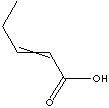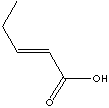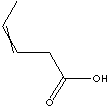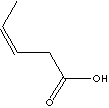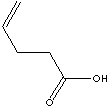PRODUCT IDENTIFICATION

H.S. CODE
TOXICITY
(E)-2,3-Dimethylacrylic acid; (E)-2-Methyl-2-butenoic acid; trans-2-Methyl crotonic acid; (E)-2-Methylbut-2-enoic acid; (E)-2-Methylbut-2-ensä ure (German); á cido (E)-2-metilbut-2-enoico (Spanish); Acide (E)-2-mé thylbut-2-é noï que (French); alpha-Methylcrotonic Acid; trans-2,3-Dimethylacrylic acid; Tiglinic acid; trans-2-Methyl-2-butenoic acid; trans-alpha,beta-Dimethylacrylic acid;
SMILES
CLASSIFICATION
Unsaturated Carboxylic Acid, Flavors and Fragrances, Biochemical ex Plants
PHYSICAL AND CHEMICAL PROPERTIES
MELTING POINT
SOLUBILITY IN WATER
AUTOIGNITION
NFPA RATINGS
REFRACTIVE INDEX
APPLICATIONS
Wikipedia Linking: http://en.wikipedia.org/wiki/Tiglic_acid
http://www.unitedteasofwellness.com/
German chamomile is often used topically in a cream or ointment to soothe
irritated skin, because of its antibacterial, antifungal, and antiviral
properties. Evidence suggests that it may be moderately effective in the
treatment of eczema. The essential oil of Roman chamomile consists chiefly of chamazulene, angelic
acid, tiglic acid, and several sesquiterpene lactones. Other constituents of
Roman chamomile include anthemic acid, athesterol, anthemene, resin and tannin.
The essential oil of German chamomile contains chamazulene, -bisabolol,
-bisabololaxides A and B, spathulenol cis-En-yn-dicycloether and farnesene.
Other constituents of German chamomile include a volatile oil, anthemic acid,
antheminidine, tannin, matricarin, and apigenin
http://harker.chem.buffalo.edu/
Single-crystal-to-single-crystal
E ! Z isomerization of tiglic acid in a supramolecular framework
http://molecules.gnu-darwin.org/mod/tiglate-more.html
tiglate Molecules Structural Archive and Gallery
APPEARANCE
97.5% min
MELTING POINT
UNSATURATED ALIPHATIC CARBOXYLIC ACID PARENT COMPOUNDS (SHORT CHAIN)
|
ACRYLIC ACID |
CH2=CHCOOH (72.06) |
|
PROPIOLIC ACID AS NUMBER : 471-25-0 EINECS NUMBER : 207-437-8 OTHER CHEMICAL NAME(S): 2-Propynoic acid Acetylenecarboxylic Acid Prop-2-ynoic acid Propargylic acid Propynoic acid MELTING POINT(S): 16 C |
CH��CHCOOH (70.05) |
|
METHACRYLIC ACID |
H2C=C(CH3)COOH (86.09) |
|
CROTONIC ACID |
CH3CH=CHCOOH (86.09) |
|
ISOCROTONIC ACID CAS NUMBER : 503-64-0 EINECS NUMBER : OTHER CHEMICAL NAME(S): (Z)-2-Butenoic acid (Z)-Crotonic acid cis-Crotonic Acid cis-2-Butenoic Acid MELTING POINT(S): |
CH3CH=CHCOOH (86.09) |
|
VINYLACETIC ACID CAS NUMBER : 625-38-7 EINECS NUMBER : 210-892-5 OTHER CHEMICAL NAME(S): 3-Butenoic acid beta-Butenoic acid Ethenyl Acetic acid MELTING POINT(S): -39 C |
CH2=CHCH2COOH (86.09) |
| 2-PENTENOIC ACID CAS NUMBER : 626-98-2 EINECS NUMBER : OTHER CHEMICAL NAME(S): Pent-2-enoic acid MELTING POINT(S): |
C2H5CH=CHCOOH (100.12) |
| trans-2-PENTENOIC ACID CAS NUMBER : 13991-37-2 EINECS NUMBER : 237-791-9 OTHER CHEMICAL NAME(S): (E)-2-Pentenoic acid (2E)-2-Pentenoic acid trans-Pent-2-enoic acid MELTING POINT(S): 9 C |
C2H5CH=CHCOOH (100.12) |
| 3-PENTENOIC ACID CAS NUMBER : 5204-64-8 EINECS NUMBER : OTHER CHEMICAL NAME(S): Pent-3-enoic acid MELTING POINT(S): |
CH3CH=CHCH2COOH (100.12) |
| trans-3-PENTENOIC ACID CAS NUMBER : 1617-32-9 EINECS NUMBER : OTHER CHEMICAL NAME(S): (E)-3-Pentenoic acid trans-Pent-3-enoic acid MELTING POINT(S): |
CH3CH=CHCH2COOH (100.12) |
| ALLYLACETIC ACID CAS NUMBER : 591-80-0 EINECS NUMBER : 209-732-7 |
CH2=CH2CH2CH2COOH (100.12) |
| MALEIC ACID CAS NUMBER : 110-16-7 EINECS NUMBER : 203-742-5 OTHER CHEMICAL NAME(S): Hydroxysuccinic Acid 2-butenedioic acid cis-1,2-ethenedicarboxylic acid cis-2-butenedioic acid cis-butenedioic acid cis-ethene-1,2-dicarboxylic acid cis-maleic acid Malenic Acid Toxilic acid (Z)-1,2-ethenedicarboxylic acid (Z)-2-butenedioic acid MELTING POINT(S): 138 C |
HOOCCH=CHCOOH (116.07) |
| FUMARIC ACID CAS NUMBER : 110-17-8 EINECS NUMBER : 203-743-0 OTHER CHEMICAL NAME(S): 2-Butenedioic acid 1,2-Ethylenedicarboxylic Acid Allomaleic Acid trans-Butanedioic Acid (E)-2-Butenedioic acid trans-1,2-Ethylenedicarboxylic acid Allomaleic acid Boletic acid MELTING POINT(S): 299 C |
HOOCCH=CHCOOH (116.07) |
|
TIGLIC ACID |
CH3CH2CH=CHCOOH (100.12) |
|
ANGELIC ACID |
CH3CH2CH=CHCOOH (100.12) |
|
CITRACONIC ACID CAS NUMBER : 498-23-7 EINECS NUMBER : 207-858-7 OTHER CHEMICAL NAME(S): Methylmaleic acid cis-Methylbutenedioic acid methyl-Maleic acid Kyselina citrakonova 2-Methyl-2-butenedioic acid (2Z)-2-Methyl-2-butenedioic acid MELTING POINT(S): 94 C |
HOOCCH=CCH3COOH (130.10) |
|
MESACONIC ACID CAS NUMBER : 498-24-8 EINECS NUMBER : 207-859-2 OTHER CHEMICAL NAME(S): trans-1-Propene-1,2-Dicarboxylic acid trans-2-Methyl-2-Butenedioic acid Methylfumaric acid 2-Methylfumaric acid (E)-2-Methyl-2-butenedioic acid (E)-methyl-Butenedioic acid Methylfumaric acid, Mesaconate Kyselina mesakonova (2E)-2-Methyl-2-butenedioic acid MELTING POINT(S): 200 C |
HOOCCH=CCH3COOH (130.10) |






